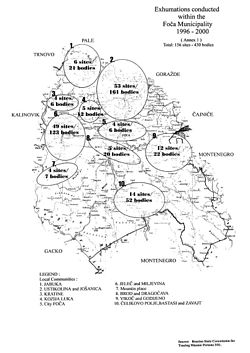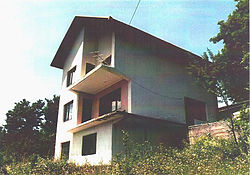- Foča massacres
-
Foča massacres 
Chart showing exhumations carried out between 1996 and 2000 in the Foča municipality, Bosnia and Herzegovina. (Photograph provided courtesy of the ICTY)Location Foča, Bosnia and Herzegovina Date April 7, 1992 to January 1994 (Central European Time) Target Bosniaks Attack type Mass killing Perpetrator(s) Serbian forces The Foča massacres, also known as the Foča genocide, were a series of killings committed by Serb military, police and paramilitary forces on Bosniak civilians in the Foča region of Bosnia and Herzegovina (including the towns of Gacko and Kalinovik) from April 7, 1992 to January 1994. In a 1997 judgement against Novislav Đajić, the Bavarian Appeals Chamber ruled that the killings in which he was involved in June 1992 were acts of genocide.[1]
In numerous verdicts, the International Criminal Tribunal for the former Yugoslavia ruled that these killings constituted crimes against humanity. Aside from mass murder, the campaign against non-Serb civilians in the region also included ethnic cleansing, mass rapes, and the deliberate destruction of Bosniak property and cultural sites. All Bosniaks were expelled from the area. Some 2,704 people from Foča are missing or were killed during the massacres period.[2] Additionally, Serb authorities set up locations - commonly described as rape camps - in which hundreds of women were raped.[3][4]
Numerous Serb officers, soldiers and other participants in the Foča massacres were accused and convicted of war crimes by the International Criminal Tribunal for the former Yugoslavia.
Contents
Attack against the civilian population
At the outset of the Bosnian war, Serb forces attacked the non-Serb civilian population in Eastern Bosnia. Once towns and villages were securely in their hands, Serb forces - i.e. the military, the police, the paramilitaries and, sometimes, even Serb villagers – applied the same pattern: Bosniak houses and apartments were systematically ransacked or burnt down while Bosniak civilians were rounded up or captured and, sometimes, beaten or killed in the process. Men and women were separated, with many of the men detained in local camps.[4]
13 mosques including the Aladža Mosque were destroyed and the 22,500 Muslims who made up the majority of inhabitants fled.[5] Only about 10 Muslims remained at the end of the conflict.[6] On January 1994, the Serb authorities renamed Foča "Srbinje" (Serbian: Србиње), literally meaning "place of the Serbs" (from Srbi Serbs and -nje which is a Slavic locative suffix).
Mass rapes
See also: Rape in the Bosnian WarBosniak women were kept in various detention centres where they had to live in intolerably unhygienic conditions and were mistreated in many ways including being repeatedly raped. Serb soldiers or policemen would come to these detention centres, select one or more women, take them out and rape them. All this was done in full view, in complete knowledge and often with the direct involvement of the Serb local authorities, particularly the police forces. The head of Foča police forces, Dragan Gagović, was personally identified as one of the men who came to these detention centres to take women out and rape them. There were numerous rape camps in Foča. "Karaman's house" was one of the most notorious rape camps. The women kept in this house were raped repeatedly. Among the women held in "Karaman's house" there were minors as young as 15 years of age.[4]
Bosniak (Bosnian Muslim) women were raped by the Serbs as part of a methodical and concentrated campaign of ethnic cleansing. For instance, the girls and women selected by the later convicted war criminal Dragoljub Kunarac or by his men, were systematically taken to the soldiers' base, a house located in Osmana Đikić street no 16. There, the women and girls (some as young as 14) were repeatedly raped. Serb soldiers regularly took Muslim girls from various detention centres and kept them as sex slaves.[4]
The other example includes Radomir Kovač, convicted also by ICTY. Radomir Kovač kept four young Muslim girls in his apartment, sexually abusing and repeatedly raping them. Kovač would also invite friends to his home and allow them to rape the girls. Kovač also sold three of the girls. Prior to selling them, Kovač gave two of his Muslim sex slaves to other Serb soldiers who gang raped them for more than three weeks. The girls were then taken back to Kovač, who immediately sold one and gave the other away as a present to his friend.[4]
War crime trials
Convicted by the International Criminal Tribunal for the former Yugoslavia:
- Dragoljub Kunarac (born 15 May 1960;[7] 28 years in prison)[4]
- Radomir Kovač (born 31 March 1961;[7] 20 years in prison)[4]
- Zoran Vuković (born 6 September 1955;[7] 12 years in prison)[4]
- Milorad Krnojelac (born 25 July 1940;[8] 12 years in prison)[9]
- Dragan Zelenović (born 12 February 1961;[10] 15 years in prison)[11]
- Milorad Krnojelac (15 years in prison;[9] granted early release)[12]
- Biljana Plavšić (11 years in prison;[13] granted early release)[14]
- Momčilo Krajišnik (20 years in prison)[15]
The trial of Radovan Karadžić, wartime President of Republika Srpska, includes crimes committed in Foča.[12] Dragan Gagović and Janko Janjić were indicted by the ICTY but died during attempts to arrest them by the SFOR in 1999 and 2000 respectively.[16]
Convicted by the Court of Bosnia and Herzegovina:
- Radovan Stanković (20 years in prison;[3] escaped from prison)[17]
- Neđo Samardžić (24 years in prison)[18]
- Gojko Janković (34 years in prison)[3]
- Savo Todorović (12 years and 6 months in prison)[19]
- Mitar Rašević (8 years and 6 months in prison)[19]
Radmilo Vuković was sentenced to five years and six months imprisonment by the Court of Bosnia and Herzegovina but later acquitted upon appeal.[20] Momčilo Mandić was acquitted of all charges.[21]
See also
- Bosnian genocide
- Serbian war crimes in the Yugoslav Wars
- List of massacres in Bosnia and Herzegovina
References
- ^ "Prosecutor v. Radislav Krstic Judgment". International Criminal Tribunal for the former Yugoslavia. 2 August 2001. http://www.icty.org/x/cases/krstic/tjug/en/krs-tj010802e.pdf. "The Federal Constitutional Court of Germany, in the Nikola Jorgic case, upheld the Judgement of the Düsseldorf Supreme Court, interpreting the intent to destroy the group "in part" as including the intention to destroy a group within a limited geographical area. In a Judgement against Novislav Djajic on 23 May 1997, the Bavarian Appeals Chamber similarly found that acts of genocide were committed in June 1992 though confined within the administrative district of Foca."
- ^ "IDC: Podrinje victim statistics". http://www.idc.org.ba/onama/izvjestaj_analize_po_centrima.html#podrinje.
- ^ a b c "ICTY: Blagojevic and Jokic judgement". http://www.icty.org/x/cases/stankovic/cis/en/cis_jankovic_stankovic_en.pdf.
- ^ a b c d e f g h "ICTY: Kunarac, Kovač and Vuković judgement". http://www.icty.org/x/cases/kunarac/acjug/en/kun-aj020612e.pdf.
- ^ Charter, David (28 May 2009). "World Agenda: US hopes for Bosnia rest on town mayor's shoulders". The Times. http://www.timesonline.co.uk/tol/news/world/europe/article6381094.ece.
- ^ "Facts about Foča". International Criminal Tribunal for the former Yugoslavia. http://www.icty.org/x/file/Outreach/view_from_hague/jit_foca_en.pdf.
- ^ a b c http://www.icty.org/x/cases/kunarac/cis
- ^ http://www.icty.org/x/cases/krnojelac/cis/en/cis_krnojelac_en.pdf
- ^ a b "Milorad Krnojelac Case Information Sheet". International Criminal Tribunal for the former Yugoslavia. http://www.icty.org/x/cases/krnojelac/cis/en/cis_krnojelac_en.pdf.
- ^ http://www.icty.org/x/cases/zelenovic/cis/en/cis_zelenovic_en.pdf
- ^ "Dragan Zelenović Case Information Sheet". International Criminal Tribunal for the former Yugoslavia. http://www.icty.org/x/cases/zelenovic/cis/en/cis_zelenovic_en.pdf.
- ^ a b "Milorad Krnojelac Returns to Foca". Balkan Investigative Reporting Network. 27 July 2009. http://www.bim.ba/en/177/10/21340/.
- ^ "Prosecutor v. Biljana Plavšić judgement". International Criminal Tribunal for the former Yugoslavia. http://www.icty.org/x/cases/plavsic/tjug/en/pla-tj030227e.pdf.
- ^ "Biljana Plavšić Case Information Sheet". International Criminal Tribunal for the former Yugoslavia. http://www.icty.org/x/cases/plavsic/cis/en/cis_plavsic_en.pdf.
- ^ "Prosecutor v. Momcilo Krajisnik judgement". International Criminal Tribunal for the former Yugoslavia. http://www.icty.org/x/cases/krajisnik/acjug/en/090317.pdf.
- ^ "Foca Confronts its Past". Human Rights Watch. 14 October 2004. http://www.hrw.org/en/news/2004/10/14/foca-confronts-its-past.
- ^ "Search for Radovan Stankovic Continues". Balkan Investigative Reporting Network. 25 May 2010. http://www.bim.ba/en/220/10/28360/.
- ^ "Final verdict handed down, sentencing Neđo Samardžić to 24 years long term imprisonment". Court of Bosnia and Herzegovina. 13 December 2006. http://www.sudbih.gov.ba/?id=314&jezik=e.
- ^ a b "Rašević Mitar and another". The Prosecutor's Office of Bosnia and Herzegovina. http://www.tuzilastvobih.gov.ba/index.php?opcija=predmeti&id=43&jezik=e.
- ^ "Vuković Radmilo". The Prosecutor's Office of Bosnia and Herzegovina. http://www.tuzilastvobih.gov.ba/?opcija=predmeti&id=35&jezik=e.
- ^ "Momčilo Mandić acquitted of all charges". Court of Bosnia and Herzegovina. 18 July 2007. http://www.sudbih.gov.ba/?id=459&jezik=e.
External links
Bosnian War Timeline 19911992 Serbian Republic of Bosnia and Herzegovina ·
Serbian Republic of Bosnia and Herzegovina ·  Republic of Bosnia and Herzegovina · Siege of Sarajevo · Siege of Bihać · Graz agreement · Croat–Bosniak War · Operation Vrbas '92 · Operation Corridor1993Kravica attack · Siege of Gornji Vakuf · Siege of Mostar · Operation Neretva '93 ·
Republic of Bosnia and Herzegovina · Siege of Sarajevo · Siege of Bihać · Graz agreement · Croat–Bosniak War · Operation Vrbas '92 · Operation Corridor1993Kravica attack · Siege of Gornji Vakuf · Siege of Mostar · Operation Neretva '93 · Autonomous Province of Western Bosnia · Operation Deny Flight19941995
Autonomous Province of Western Bosnia · Operation Deny Flight19941995War Crimes Ethnic cleansingAhatovići · Ahmići · Bijeljina · Biljani · Čemerno · Doboj · Dobrinja · Doljani · Duša · Foča · Glogova · Grabovica · Kiseljak · Korićani Cliffs · Kravica · Lašva Valley · Makljen · Markale · Mokronoge · Prijedor · Prozor · Raštani · Srebrenica · Stolac · Stupni Do · Štrpci · Tuzla · Višegrad (Barimo, Bosanska Jagodina, Paklenik, Sjeverin) · Vlasenica · Vrbanja · Zaklopača · ZvornikCampsCasesCategories:- Conflicts in 1992
- Conflicts in 1993
- Conflicts in 1994
- Bosnian Genocide
- Massacres in Bosnia and Herzegovina
- Ethnic cleansing
- War crimes in former Yugoslavia
- War crimes in Bosnia and Herzegovina
- Bosnian War
- 1992 in Bosnia and Herzegovina
- 1993 in Bosnia and Herzegovina
- 1994 in Bosnia and Herzegovina
- Serbian war crimes
Wikimedia Foundation. 2010.

